HR Devolution at Snow Mountain Hotel: A Strategic Case Analysis
VerifiedAdded on 2023/04/19
|15
|3368
|189
Case Study
AI Summary
This case study examines the devolution of HR responsibilities at the Snow Mountain Hotel, focusing on the implementation of a business partner model, the use of shared service centers, and the delegation of HR duties to line managers. It discusses the characteristics of the business partner model, including its strategic partner, administrative expert, employee champion, and change agent roles. The study identifies challenges faced by the hotel, such as increasing competition and negative attitudes from line managers, and assesses the value of HR's strategic involvement. It further explores the hard and soft approaches to HRM and highlights barriers to the model, advantages, and disadvantages. The analysis extends to shared service centers, their internal and external drivers, and the pros and cons of their implementation. Finally, it addresses practical issues in engaging line managers and HR to ensure effective collaboration. Desklib provides access to similar case studies and solved assignments for students.

Devolution of HR responsibilities 0
Snow Mountain Hotel Case Study
Student’s Name
12/31/2018
Snow Mountain Hotel Case Study
Student’s Name
12/31/2018
Paraphrase This Document
Need a fresh take? Get an instant paraphrase of this document with our AI Paraphraser

Devolution of HR responsibilities 1
Contents
Introduction................................................................................................................................2
Business Partner Model..............................................................................................................2
Characteristics of the business partner model........................................................................3
The challenges faced by the SNOW mountain hotel are.......................................................5
Value To the organization..........................................................................................................5
A hard and soft approach to HRM.........................................................................................5
Bottom Line performance......................................................................................................6
Barriers to the model..............................................................................................................6
Advantages of using Business Partner Model........................................................................7
Disadvantages of using Business Partner Model...................................................................7
Shared Service Centres..............................................................................................................8
Internal and external drivers for growing distributed service centres....................................8
Advantages and disadvantages of the shared service centre..................................................8
Disadvantages of Shared service centre.................................................................................9
Devolution of the HR responsibilities to the line managers....................................................10
Practical issues that have to be addressed to ensure the engagement of the line managers
and the HR............................................................................................................................10
Conclusion................................................................................................................................11
References................................................................................................................................12
Contents
Introduction................................................................................................................................2
Business Partner Model..............................................................................................................2
Characteristics of the business partner model........................................................................3
The challenges faced by the SNOW mountain hotel are.......................................................5
Value To the organization..........................................................................................................5
A hard and soft approach to HRM.........................................................................................5
Bottom Line performance......................................................................................................6
Barriers to the model..............................................................................................................6
Advantages of using Business Partner Model........................................................................7
Disadvantages of using Business Partner Model...................................................................7
Shared Service Centres..............................................................................................................8
Internal and external drivers for growing distributed service centres....................................8
Advantages and disadvantages of the shared service centre..................................................8
Disadvantages of Shared service centre.................................................................................9
Devolution of the HR responsibilities to the line managers....................................................10
Practical issues that have to be addressed to ensure the engagement of the line managers
and the HR............................................................................................................................10
Conclusion................................................................................................................................11
References................................................................................................................................12
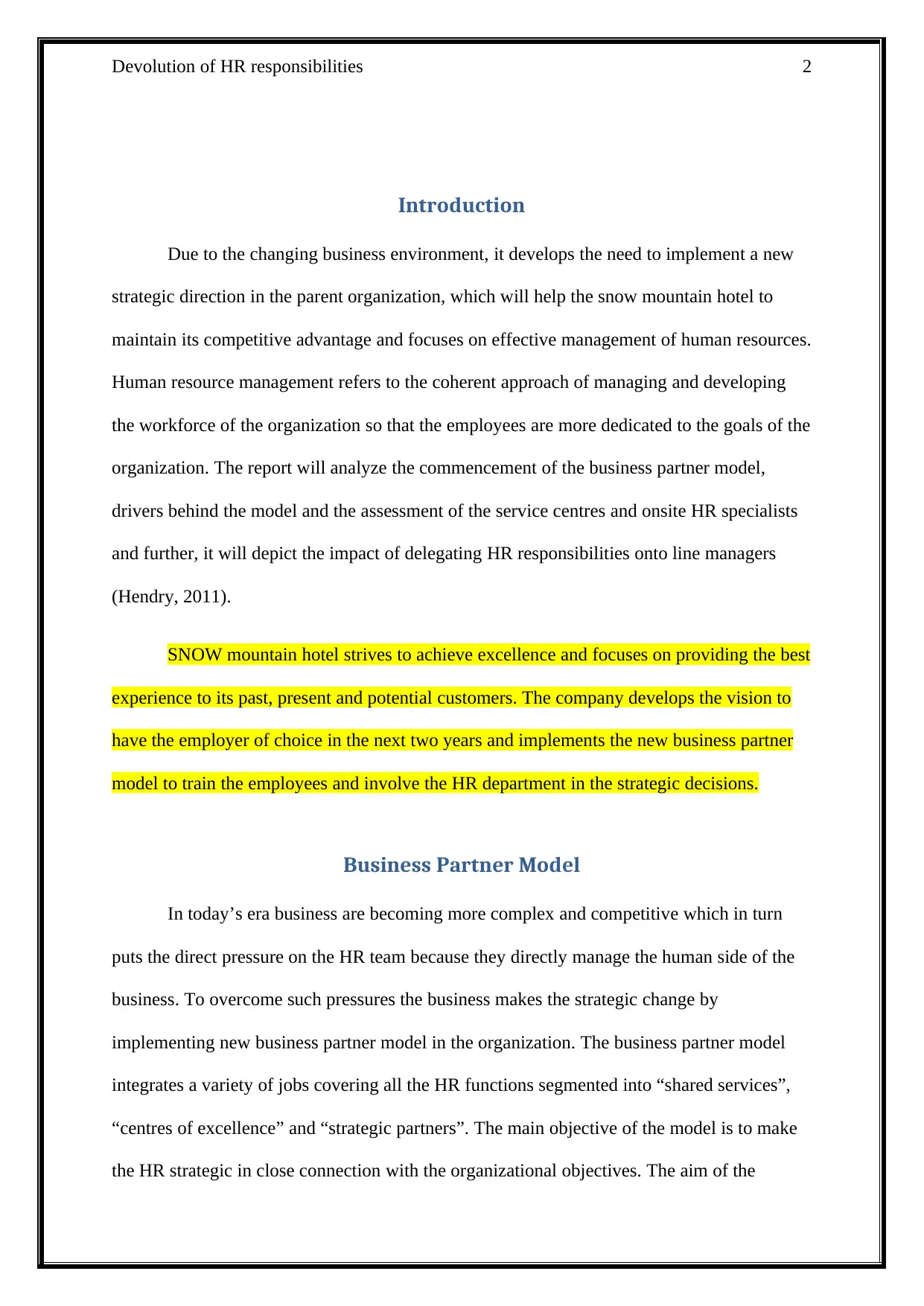
Devolution of HR responsibilities 2
Introduction
Due to the changing business environment, it develops the need to implement a new
strategic direction in the parent organization, which will help the snow mountain hotel to
maintain its competitive advantage and focuses on effective management of human resources.
Human resource management refers to the coherent approach of managing and developing
the workforce of the organization so that the employees are more dedicated to the goals of the
organization. The report will analyze the commencement of the business partner model,
drivers behind the model and the assessment of the service centres and onsite HR specialists
and further, it will depict the impact of delegating HR responsibilities onto line managers
(Hendry, 2011).
SNOW mountain hotel strives to achieve excellence and focuses on providing the best
experience to its past, present and potential customers. The company develops the vision to
have the employer of choice in the next two years and implements the new business partner
model to train the employees and involve the HR department in the strategic decisions.
Business Partner Model
In today’s era business are becoming more complex and competitive which in turn
puts the direct pressure on the HR team because they directly manage the human side of the
business. To overcome such pressures the business makes the strategic change by
implementing new business partner model in the organization. The business partner model
integrates a variety of jobs covering all the HR functions segmented into “shared services”,
“centres of excellence” and “strategic partners”. The main objective of the model is to make
the HR strategic in close connection with the organizational objectives. The aim of the
Introduction
Due to the changing business environment, it develops the need to implement a new
strategic direction in the parent organization, which will help the snow mountain hotel to
maintain its competitive advantage and focuses on effective management of human resources.
Human resource management refers to the coherent approach of managing and developing
the workforce of the organization so that the employees are more dedicated to the goals of the
organization. The report will analyze the commencement of the business partner model,
drivers behind the model and the assessment of the service centres and onsite HR specialists
and further, it will depict the impact of delegating HR responsibilities onto line managers
(Hendry, 2011).
SNOW mountain hotel strives to achieve excellence and focuses on providing the best
experience to its past, present and potential customers. The company develops the vision to
have the employer of choice in the next two years and implements the new business partner
model to train the employees and involve the HR department in the strategic decisions.
Business Partner Model
In today’s era business are becoming more complex and competitive which in turn
puts the direct pressure on the HR team because they directly manage the human side of the
business. To overcome such pressures the business makes the strategic change by
implementing new business partner model in the organization. The business partner model
integrates a variety of jobs covering all the HR functions segmented into “shared services”,
“centres of excellence” and “strategic partners”. The main objective of the model is to make
the HR strategic in close connection with the organizational objectives. The aim of the
⊘ This is a preview!⊘
Do you want full access?
Subscribe today to unlock all pages.

Trusted by 1+ million students worldwide
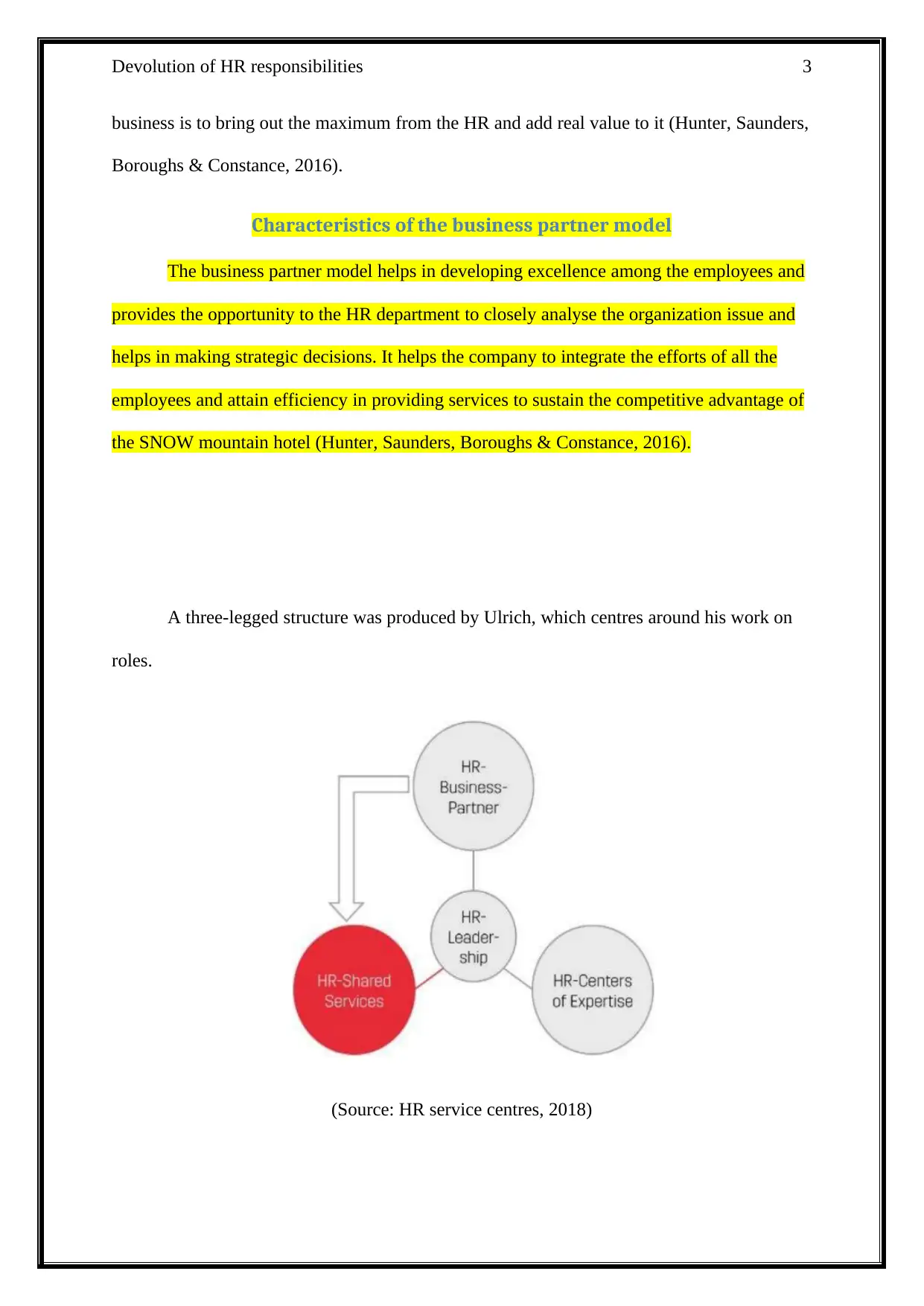
Devolution of HR responsibilities 3
business is to bring out the maximum from the HR and add real value to it (Hunter, Saunders,
Boroughs & Constance, 2016).
Characteristics of the business partner model
The business partner model helps in developing excellence among the employees and
provides the opportunity to the HR department to closely analyse the organization issue and
helps in making strategic decisions. It helps the company to integrate the efforts of all the
employees and attain efficiency in providing services to sustain the competitive advantage of
the SNOW mountain hotel (Hunter, Saunders, Boroughs & Constance, 2016).
A three-legged structure was produced by Ulrich, which centres around his work on
roles.
(Source: HR service centres, 2018)
business is to bring out the maximum from the HR and add real value to it (Hunter, Saunders,
Boroughs & Constance, 2016).
Characteristics of the business partner model
The business partner model helps in developing excellence among the employees and
provides the opportunity to the HR department to closely analyse the organization issue and
helps in making strategic decisions. It helps the company to integrate the efforts of all the
employees and attain efficiency in providing services to sustain the competitive advantage of
the SNOW mountain hotel (Hunter, Saunders, Boroughs & Constance, 2016).
A three-legged structure was produced by Ulrich, which centres around his work on
roles.
(Source: HR service centres, 2018)
Paraphrase This Document
Need a fresh take? Get an instant paraphrase of this document with our AI Paraphraser
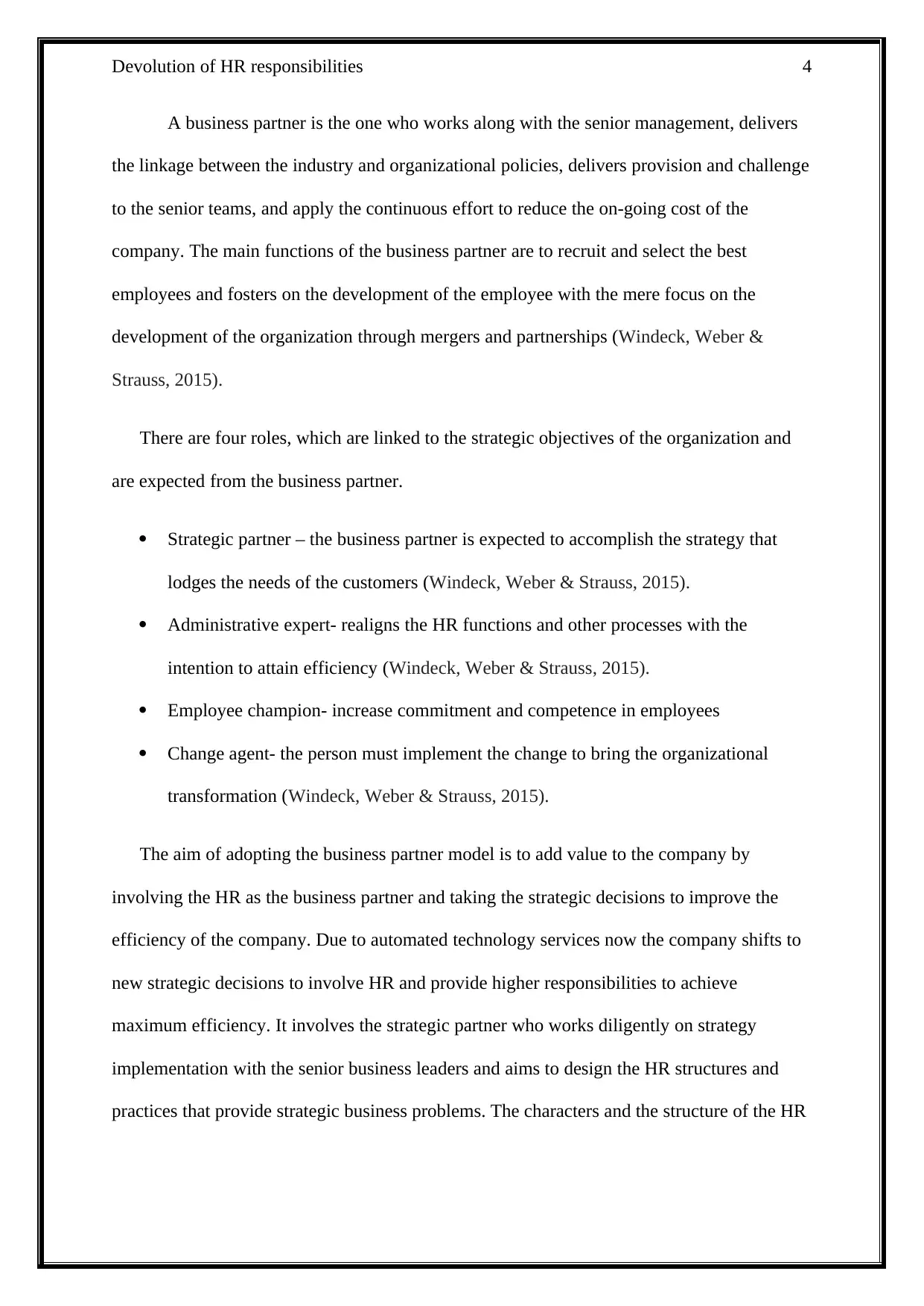
Devolution of HR responsibilities 4
A business partner is the one who works along with the senior management, delivers
the linkage between the industry and organizational policies, delivers provision and challenge
to the senior teams, and apply the continuous effort to reduce the on-going cost of the
company. The main functions of the business partner are to recruit and select the best
employees and fosters on the development of the employee with the mere focus on the
development of the organization through mergers and partnerships (Windeck, Weber &
Strauss, 2015).
There are four roles, which are linked to the strategic objectives of the organization and
are expected from the business partner.
Strategic partner – the business partner is expected to accomplish the strategy that
lodges the needs of the customers (Windeck, Weber & Strauss, 2015).
Administrative expert- realigns the HR functions and other processes with the
intention to attain efficiency (Windeck, Weber & Strauss, 2015).
Employee champion- increase commitment and competence in employees
Change agent- the person must implement the change to bring the organizational
transformation (Windeck, Weber & Strauss, 2015).
The aim of adopting the business partner model is to add value to the company by
involving the HR as the business partner and taking the strategic decisions to improve the
efficiency of the company. Due to automated technology services now the company shifts to
new strategic decisions to involve HR and provide higher responsibilities to achieve
maximum efficiency. It involves the strategic partner who works diligently on strategy
implementation with the senior business leaders and aims to design the HR structures and
practices that provide strategic business problems. The characters and the structure of the HR
A business partner is the one who works along with the senior management, delivers
the linkage between the industry and organizational policies, delivers provision and challenge
to the senior teams, and apply the continuous effort to reduce the on-going cost of the
company. The main functions of the business partner are to recruit and select the best
employees and fosters on the development of the employee with the mere focus on the
development of the organization through mergers and partnerships (Windeck, Weber &
Strauss, 2015).
There are four roles, which are linked to the strategic objectives of the organization and
are expected from the business partner.
Strategic partner – the business partner is expected to accomplish the strategy that
lodges the needs of the customers (Windeck, Weber & Strauss, 2015).
Administrative expert- realigns the HR functions and other processes with the
intention to attain efficiency (Windeck, Weber & Strauss, 2015).
Employee champion- increase commitment and competence in employees
Change agent- the person must implement the change to bring the organizational
transformation (Windeck, Weber & Strauss, 2015).
The aim of adopting the business partner model is to add value to the company by
involving the HR as the business partner and taking the strategic decisions to improve the
efficiency of the company. Due to automated technology services now the company shifts to
new strategic decisions to involve HR and provide higher responsibilities to achieve
maximum efficiency. It involves the strategic partner who works diligently on strategy
implementation with the senior business leaders and aims to design the HR structures and
practices that provide strategic business problems. The characters and the structure of the HR
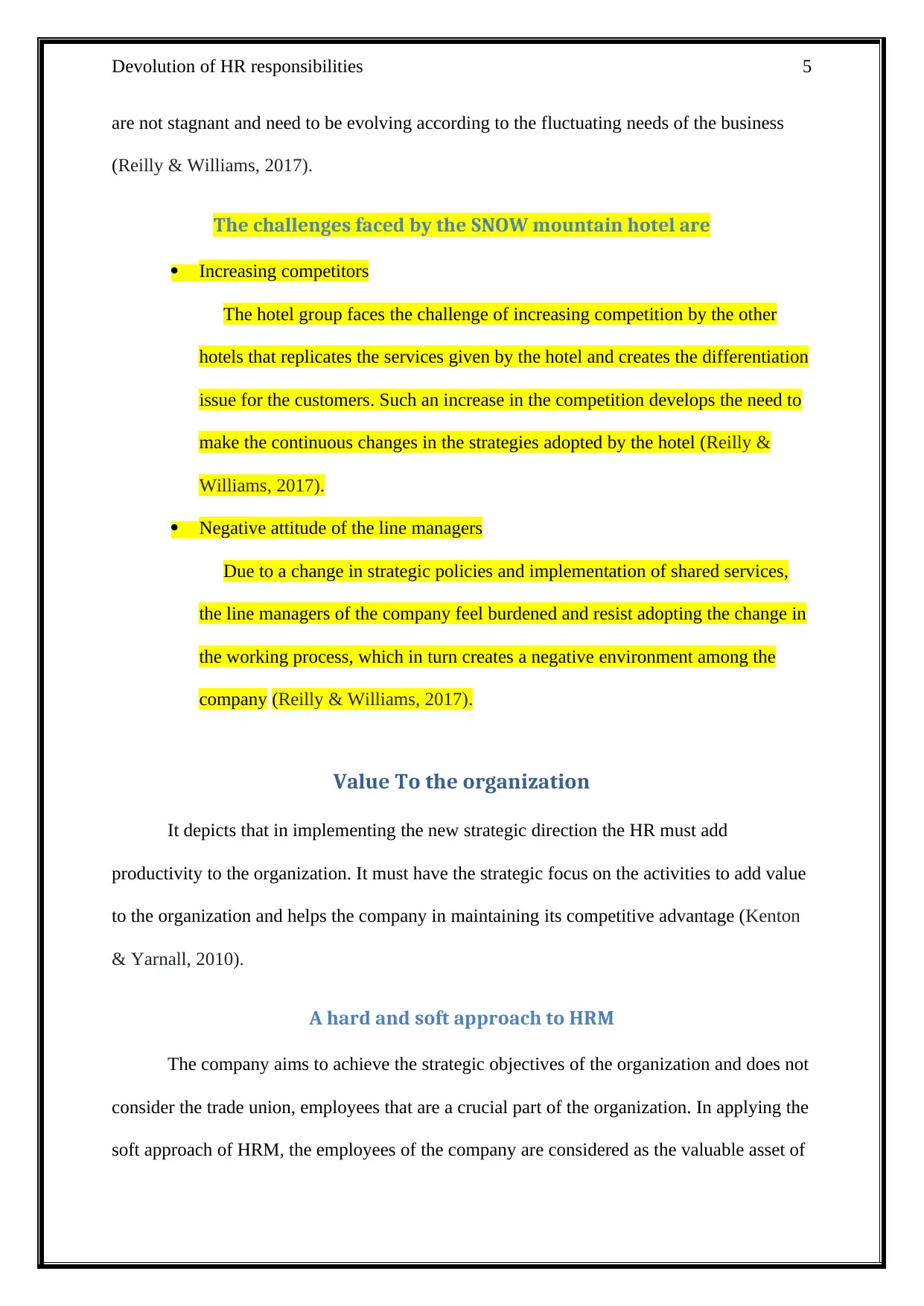
Devolution of HR responsibilities 5
are not stagnant and need to be evolving according to the fluctuating needs of the business
(Reilly & Williams, 2017).
The challenges faced by the SNOW mountain hotel are
Increasing competitors
The hotel group faces the challenge of increasing competition by the other
hotels that replicates the services given by the hotel and creates the differentiation
issue for the customers. Such an increase in the competition develops the need to
make the continuous changes in the strategies adopted by the hotel (Reilly &
Williams, 2017).
Negative attitude of the line managers
Due to a change in strategic policies and implementation of shared services,
the line managers of the company feel burdened and resist adopting the change in
the working process, which in turn creates a negative environment among the
company (Reilly & Williams, 2017).
Value To the organization
It depicts that in implementing the new strategic direction the HR must add
productivity to the organization. It must have the strategic focus on the activities to add value
to the organization and helps the company in maintaining its competitive advantage (Kenton
& Yarnall, 2010).
A hard and soft approach to HRM
The company aims to achieve the strategic objectives of the organization and does not
consider the trade union, employees that are a crucial part of the organization. In applying the
soft approach of HRM, the employees of the company are considered as the valuable asset of
are not stagnant and need to be evolving according to the fluctuating needs of the business
(Reilly & Williams, 2017).
The challenges faced by the SNOW mountain hotel are
Increasing competitors
The hotel group faces the challenge of increasing competition by the other
hotels that replicates the services given by the hotel and creates the differentiation
issue for the customers. Such an increase in the competition develops the need to
make the continuous changes in the strategies adopted by the hotel (Reilly &
Williams, 2017).
Negative attitude of the line managers
Due to a change in strategic policies and implementation of shared services,
the line managers of the company feel burdened and resist adopting the change in
the working process, which in turn creates a negative environment among the
company (Reilly & Williams, 2017).
Value To the organization
It depicts that in implementing the new strategic direction the HR must add
productivity to the organization. It must have the strategic focus on the activities to add value
to the organization and helps the company in maintaining its competitive advantage (Kenton
& Yarnall, 2010).
A hard and soft approach to HRM
The company aims to achieve the strategic objectives of the organization and does not
consider the trade union, employees that are a crucial part of the organization. In applying the
soft approach of HRM, the employees of the company are considered as the valuable asset of
⊘ This is a preview!⊘
Do you want full access?
Subscribe today to unlock all pages.

Trusted by 1+ million students worldwide
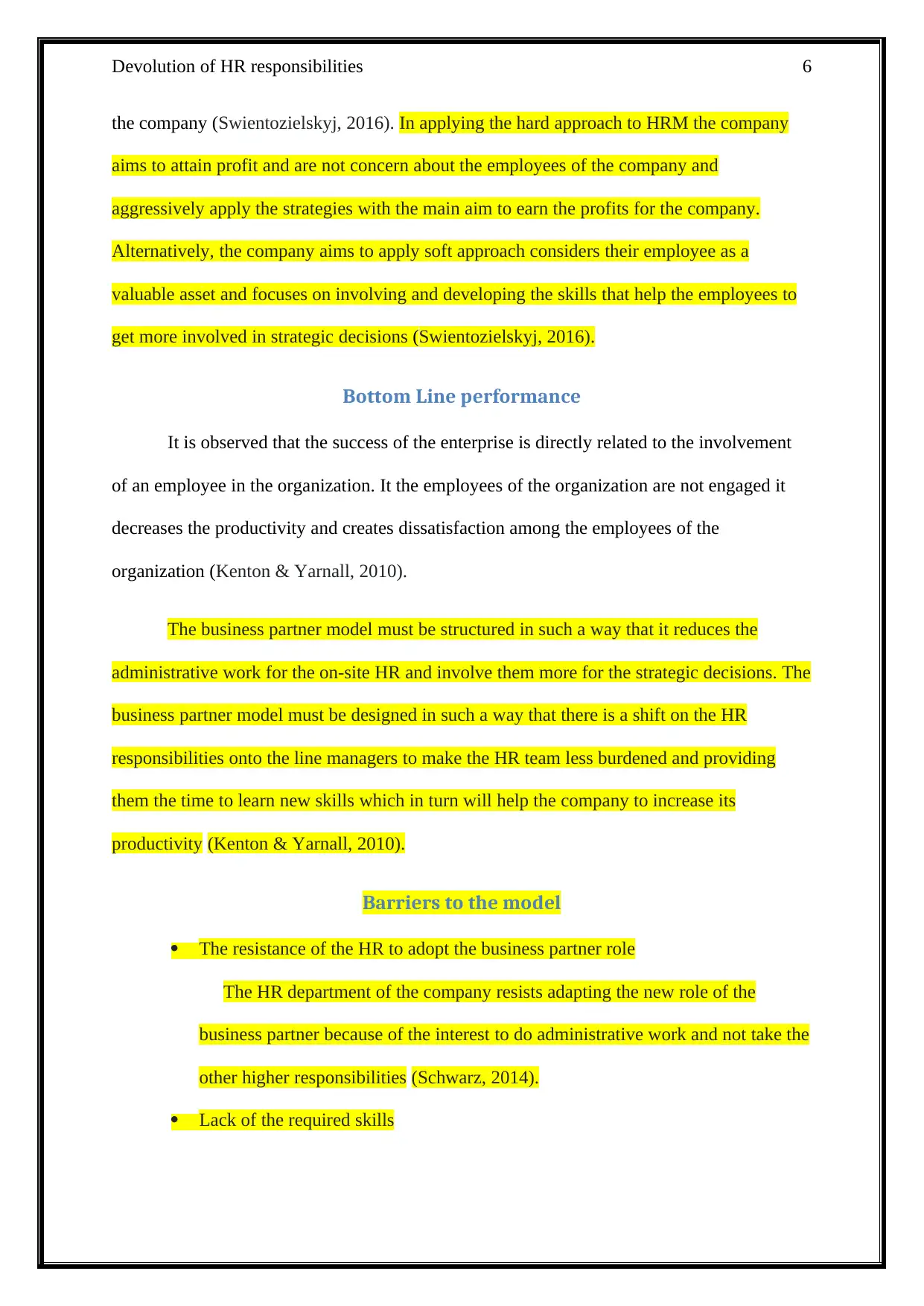
Devolution of HR responsibilities 6
the company (Swientozielskyj, 2016). In applying the hard approach to HRM the company
aims to attain profit and are not concern about the employees of the company and
aggressively apply the strategies with the main aim to earn the profits for the company.
Alternatively, the company aims to apply soft approach considers their employee as a
valuable asset and focuses on involving and developing the skills that help the employees to
get more involved in strategic decisions (Swientozielskyj, 2016).
Bottom Line performance
It is observed that the success of the enterprise is directly related to the involvement
of an employee in the organization. It the employees of the organization are not engaged it
decreases the productivity and creates dissatisfaction among the employees of the
organization (Kenton & Yarnall, 2010).
The business partner model must be structured in such a way that it reduces the
administrative work for the on-site HR and involve them more for the strategic decisions. The
business partner model must be designed in such a way that there is a shift on the HR
responsibilities onto the line managers to make the HR team less burdened and providing
them the time to learn new skills which in turn will help the company to increase its
productivity (Kenton & Yarnall, 2010).
Barriers to the model
The resistance of the HR to adopt the business partner role
The HR department of the company resists adapting the new role of the
business partner because of the interest to do administrative work and not take the
other higher responsibilities (Schwarz, 2014).
Lack of the required skills
the company (Swientozielskyj, 2016). In applying the hard approach to HRM the company
aims to attain profit and are not concern about the employees of the company and
aggressively apply the strategies with the main aim to earn the profits for the company.
Alternatively, the company aims to apply soft approach considers their employee as a
valuable asset and focuses on involving and developing the skills that help the employees to
get more involved in strategic decisions (Swientozielskyj, 2016).
Bottom Line performance
It is observed that the success of the enterprise is directly related to the involvement
of an employee in the organization. It the employees of the organization are not engaged it
decreases the productivity and creates dissatisfaction among the employees of the
organization (Kenton & Yarnall, 2010).
The business partner model must be structured in such a way that it reduces the
administrative work for the on-site HR and involve them more for the strategic decisions. The
business partner model must be designed in such a way that there is a shift on the HR
responsibilities onto the line managers to make the HR team less burdened and providing
them the time to learn new skills which in turn will help the company to increase its
productivity (Kenton & Yarnall, 2010).
Barriers to the model
The resistance of the HR to adopt the business partner role
The HR department of the company resists adapting the new role of the
business partner because of the interest to do administrative work and not take the
other higher responsibilities (Schwarz, 2014).
Lack of the required skills
Paraphrase This Document
Need a fresh take? Get an instant paraphrase of this document with our AI Paraphraser

Devolution of HR responsibilities 7
The HR department does not have the required skills to involve them in the
strategic change and allocate higher responsibilities of a business partner
(Schwarz, 2014).
Advantages of using Business Partner Model
The potential advantages of implementing a business partner model are that the
overall cost of the company can be reduced and it is simpler than implementing merger and
acquisitions. Implementation of business partner model helps the company to maintain its
competitive advantage by cooperating and collaborating the revenue, investments and
occupation. The HR has become central to the company and should be equipped, challenging,
motivating, competitive and committed. It fosters that the attitude and the behaviour of the
employees must be more positive (Swientozielskyj, 2016).
Disadvantages of using Business Partner Model
The potential disadvantages of using this model are that a clear set of needs should be
there to implement the change. Without the clear identification of the rationale needs the
efficiency in the expected needs will not be achieved. There should be proper allocation of
the time to understand the role and make the necessary adjustments required by the
organization. In implementing this model it is often assumed that the HR has the required
skills and the behaviour to move into the business partner role (Kenton & Yarnall, 2010).
The HR department does not have the required skills to involve them in the
strategic change and allocate higher responsibilities of a business partner
(Schwarz, 2014).
Advantages of using Business Partner Model
The potential advantages of implementing a business partner model are that the
overall cost of the company can be reduced and it is simpler than implementing merger and
acquisitions. Implementation of business partner model helps the company to maintain its
competitive advantage by cooperating and collaborating the revenue, investments and
occupation. The HR has become central to the company and should be equipped, challenging,
motivating, competitive and committed. It fosters that the attitude and the behaviour of the
employees must be more positive (Swientozielskyj, 2016).
Disadvantages of using Business Partner Model
The potential disadvantages of using this model are that a clear set of needs should be
there to implement the change. Without the clear identification of the rationale needs the
efficiency in the expected needs will not be achieved. There should be proper allocation of
the time to understand the role and make the necessary adjustments required by the
organization. In implementing this model it is often assumed that the HR has the required
skills and the behaviour to move into the business partner role (Kenton & Yarnall, 2010).
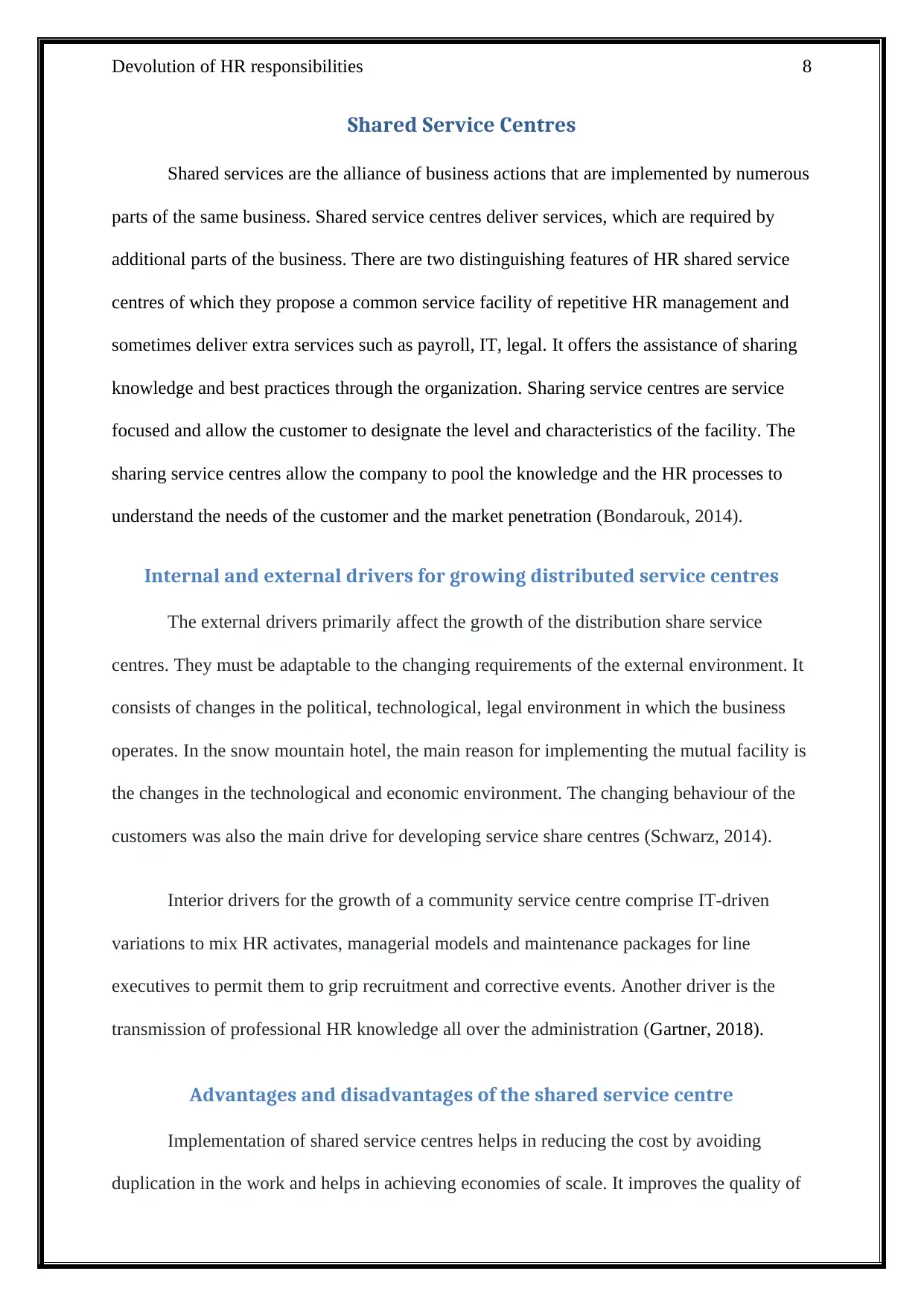
Devolution of HR responsibilities 8
Shared Service Centres
Shared services are the alliance of business actions that are implemented by numerous
parts of the same business. Shared service centres deliver services, which are required by
additional parts of the business. There are two distinguishing features of HR shared service
centres of which they propose a common service facility of repetitive HR management and
sometimes deliver extra services such as payroll, IT, legal. It offers the assistance of sharing
knowledge and best practices through the organization. Sharing service centres are service
focused and allow the customer to designate the level and characteristics of the facility. The
sharing service centres allow the company to pool the knowledge and the HR processes to
understand the needs of the customer and the market penetration (Bondarouk, 2014).
Internal and external drivers for growing distributed service centres
The external drivers primarily affect the growth of the distribution share service
centres. They must be adaptable to the changing requirements of the external environment. It
consists of changes in the political, technological, legal environment in which the business
operates. In the snow mountain hotel, the main reason for implementing the mutual facility is
the changes in the technological and economic environment. The changing behaviour of the
customers was also the main drive for developing service share centres (Schwarz, 2014).
Interior drivers for the growth of a community service centre comprise IT-driven
variations to mix HR activates, managerial models and maintenance packages for line
executives to permit them to grip recruitment and corrective events. Another driver is the
transmission of professional HR knowledge all over the administration (Gartner, 2018).
Advantages and disadvantages of the shared service centre
Implementation of shared service centres helps in reducing the cost by avoiding
duplication in the work and helps in achieving economies of scale. It improves the quality of
Shared Service Centres
Shared services are the alliance of business actions that are implemented by numerous
parts of the same business. Shared service centres deliver services, which are required by
additional parts of the business. There are two distinguishing features of HR shared service
centres of which they propose a common service facility of repetitive HR management and
sometimes deliver extra services such as payroll, IT, legal. It offers the assistance of sharing
knowledge and best practices through the organization. Sharing service centres are service
focused and allow the customer to designate the level and characteristics of the facility. The
sharing service centres allow the company to pool the knowledge and the HR processes to
understand the needs of the customer and the market penetration (Bondarouk, 2014).
Internal and external drivers for growing distributed service centres
The external drivers primarily affect the growth of the distribution share service
centres. They must be adaptable to the changing requirements of the external environment. It
consists of changes in the political, technological, legal environment in which the business
operates. In the snow mountain hotel, the main reason for implementing the mutual facility is
the changes in the technological and economic environment. The changing behaviour of the
customers was also the main drive for developing service share centres (Schwarz, 2014).
Interior drivers for the growth of a community service centre comprise IT-driven
variations to mix HR activates, managerial models and maintenance packages for line
executives to permit them to grip recruitment and corrective events. Another driver is the
transmission of professional HR knowledge all over the administration (Gartner, 2018).
Advantages and disadvantages of the shared service centre
Implementation of shared service centres helps in reducing the cost by avoiding
duplication in the work and helps in achieving economies of scale. It improves the quality of
⊘ This is a preview!⊘
Do you want full access?
Subscribe today to unlock all pages.

Trusted by 1+ million students worldwide
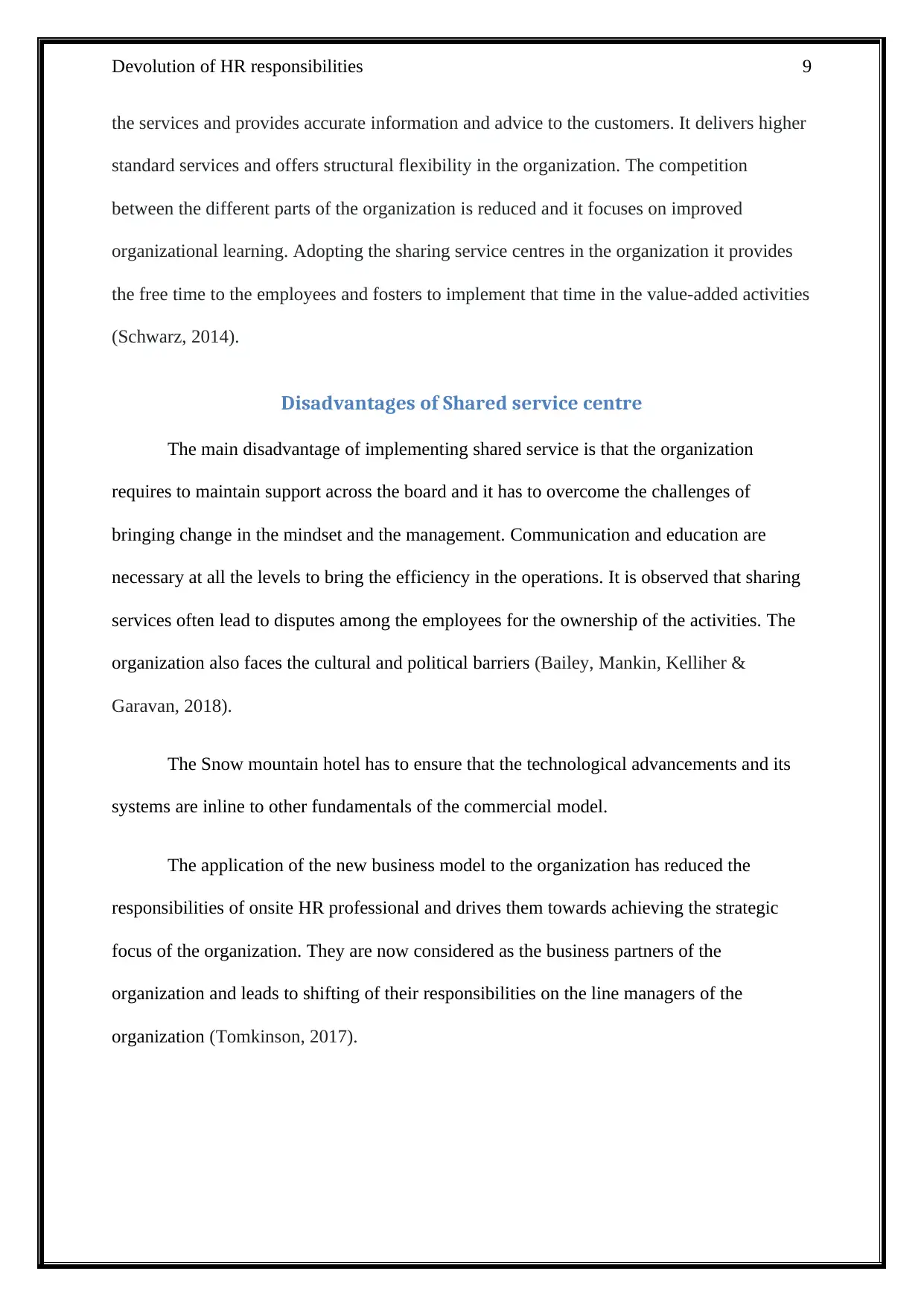
Devolution of HR responsibilities 9
the services and provides accurate information and advice to the customers. It delivers higher
standard services and offers structural flexibility in the organization. The competition
between the different parts of the organization is reduced and it focuses on improved
organizational learning. Adopting the sharing service centres in the organization it provides
the free time to the employees and fosters to implement that time in the value-added activities
(Schwarz, 2014).
Disadvantages of Shared service centre
The main disadvantage of implementing shared service is that the organization
requires to maintain support across the board and it has to overcome the challenges of
bringing change in the mindset and the management. Communication and education are
necessary at all the levels to bring the efficiency in the operations. It is observed that sharing
services often lead to disputes among the employees for the ownership of the activities. The
organization also faces the cultural and political barriers (Bailey, Mankin, Kelliher &
Garavan, 2018).
The Snow mountain hotel has to ensure that the technological advancements and its
systems are inline to other fundamentals of the commercial model.
The application of the new business model to the organization has reduced the
responsibilities of onsite HR professional and drives them towards achieving the strategic
focus of the organization. They are now considered as the business partners of the
organization and leads to shifting of their responsibilities on the line managers of the
organization (Tomkinson, 2017).
the services and provides accurate information and advice to the customers. It delivers higher
standard services and offers structural flexibility in the organization. The competition
between the different parts of the organization is reduced and it focuses on improved
organizational learning. Adopting the sharing service centres in the organization it provides
the free time to the employees and fosters to implement that time in the value-added activities
(Schwarz, 2014).
Disadvantages of Shared service centre
The main disadvantage of implementing shared service is that the organization
requires to maintain support across the board and it has to overcome the challenges of
bringing change in the mindset and the management. Communication and education are
necessary at all the levels to bring the efficiency in the operations. It is observed that sharing
services often lead to disputes among the employees for the ownership of the activities. The
organization also faces the cultural and political barriers (Bailey, Mankin, Kelliher &
Garavan, 2018).
The Snow mountain hotel has to ensure that the technological advancements and its
systems are inline to other fundamentals of the commercial model.
The application of the new business model to the organization has reduced the
responsibilities of onsite HR professional and drives them towards achieving the strategic
focus of the organization. They are now considered as the business partners of the
organization and leads to shifting of their responsibilities on the line managers of the
organization (Tomkinson, 2017).
Paraphrase This Document
Need a fresh take? Get an instant paraphrase of this document with our AI Paraphraser

Devolution of HR responsibilities 10
Devolution of the HR responsibilities to the line managers
The organization operates in the environment, which is competitive, and to maintain
its competitive advantage the hotel aims to realign its strategic focus. The company applies
the soft approach of HRM because they consider employees as their asset and satisfaction of
the employees is their highest priority. Devolution of the HR accountabilities to the line
executives allows the manager to have close control over the workings and the procedures of
the organization. It allows the HR personnel to have free time and implement that time into
the activities that add value to the organization. The line managers are an important link
between the organization and the customers. It aims to maximise the potential of the leaders
(Trullen, Stirpe, Bonache, & Valverde, 2016).
It is analysed that in case of snow mountain hotel the line managers deliver the
negative attitude towards taking of the HR responsibilities because they said that 40% of their
time gets devotes in managing the HR issues and gets frustrated from the legal constraints
and complains of the union representatives. They have the priority in competing and lead to
inconsistencies in the application of the HR policies (Ellstrom & Ellstrom, 2018).
Practical issues that have to be addressed to ensure the engagement of the
line managers and the HR
It is analysed that to overcome the challenges of the organization it is important for
the senior manager to recruit the trainee that will provide training to the HR and the line
managers to execute the actions of the organization (AZ central, 2018).
In the implementation of the activities, it is observed that the activities performed by
the HR are not included at the time of setting of objectives and are not implemented. The
activities are not considered at the time of analysis the performance of the managers
(Reflektive, 2018).
Devolution of the HR responsibilities to the line managers
The organization operates in the environment, which is competitive, and to maintain
its competitive advantage the hotel aims to realign its strategic focus. The company applies
the soft approach of HRM because they consider employees as their asset and satisfaction of
the employees is their highest priority. Devolution of the HR accountabilities to the line
executives allows the manager to have close control over the workings and the procedures of
the organization. It allows the HR personnel to have free time and implement that time into
the activities that add value to the organization. The line managers are an important link
between the organization and the customers. It aims to maximise the potential of the leaders
(Trullen, Stirpe, Bonache, & Valverde, 2016).
It is analysed that in case of snow mountain hotel the line managers deliver the
negative attitude towards taking of the HR responsibilities because they said that 40% of their
time gets devotes in managing the HR issues and gets frustrated from the legal constraints
and complains of the union representatives. They have the priority in competing and lead to
inconsistencies in the application of the HR policies (Ellstrom & Ellstrom, 2018).
Practical issues that have to be addressed to ensure the engagement of the
line managers and the HR
It is analysed that to overcome the challenges of the organization it is important for
the senior manager to recruit the trainee that will provide training to the HR and the line
managers to execute the actions of the organization (AZ central, 2018).
In the implementation of the activities, it is observed that the activities performed by
the HR are not included at the time of setting of objectives and are not implemented. The
activities are not considered at the time of analysis the performance of the managers
(Reflektive, 2018).

Devolution of HR responsibilities 11
The line manager depicts the negative attitude towards the responsibilities of the HR,
which are being devolved to them. They do not understand how to implement them in
achieving the goal of the organization and consider these responsibilities as a burden on them
(AZ central, 2018).
The HR and line manager do not understand what value they have to add to the
organization because they do not have the skill and was not able to transfer the knowledge.
These two factors are considered crucial for devolution of the responsibilities from HR to line
manager.
It is analysed that the line managers do not have the skills to consider people
management when implementing the responsibilities of the HR. The manager must have the
required skill to bring the efficiency in operations of the organization (HRM, 2015).
The line managers must receive the support for undertaking the problems occur while
implementing the responsibilities of the HR due to lack of the required skill.
Conclusion
From the above discussion, it is concluded that in order to maintain its competitive
advantage over its competitors the snow mountain hotel must adopt the shared service
centres, which will help the HR to have a strategic focus and will lead to increase in the
efficiency of the organization. The main aim of implementing the business partner model is
to consider HR as the business partner and is expected to bring operational efficiency in the
organization. The company must focus on delivering adequate training to the line managers
so that they are able to develop the required skills in carrying the responsibilities of the HR.
The line manager depicts the negative attitude towards the responsibilities of the HR,
which are being devolved to them. They do not understand how to implement them in
achieving the goal of the organization and consider these responsibilities as a burden on them
(AZ central, 2018).
The HR and line manager do not understand what value they have to add to the
organization because they do not have the skill and was not able to transfer the knowledge.
These two factors are considered crucial for devolution of the responsibilities from HR to line
manager.
It is analysed that the line managers do not have the skills to consider people
management when implementing the responsibilities of the HR. The manager must have the
required skill to bring the efficiency in operations of the organization (HRM, 2015).
The line managers must receive the support for undertaking the problems occur while
implementing the responsibilities of the HR due to lack of the required skill.
Conclusion
From the above discussion, it is concluded that in order to maintain its competitive
advantage over its competitors the snow mountain hotel must adopt the shared service
centres, which will help the HR to have a strategic focus and will lead to increase in the
efficiency of the organization. The main aim of implementing the business partner model is
to consider HR as the business partner and is expected to bring operational efficiency in the
organization. The company must focus on delivering adequate training to the line managers
so that they are able to develop the required skills in carrying the responsibilities of the HR.
⊘ This is a preview!⊘
Do you want full access?
Subscribe today to unlock all pages.

Trusted by 1+ million students worldwide
1 out of 15
Related Documents
Your All-in-One AI-Powered Toolkit for Academic Success.
+13062052269
info@desklib.com
Available 24*7 on WhatsApp / Email
![[object Object]](/_next/static/media/star-bottom.7253800d.svg)
Unlock your academic potential
Copyright © 2020–2025 A2Z Services. All Rights Reserved. Developed and managed by ZUCOL.



